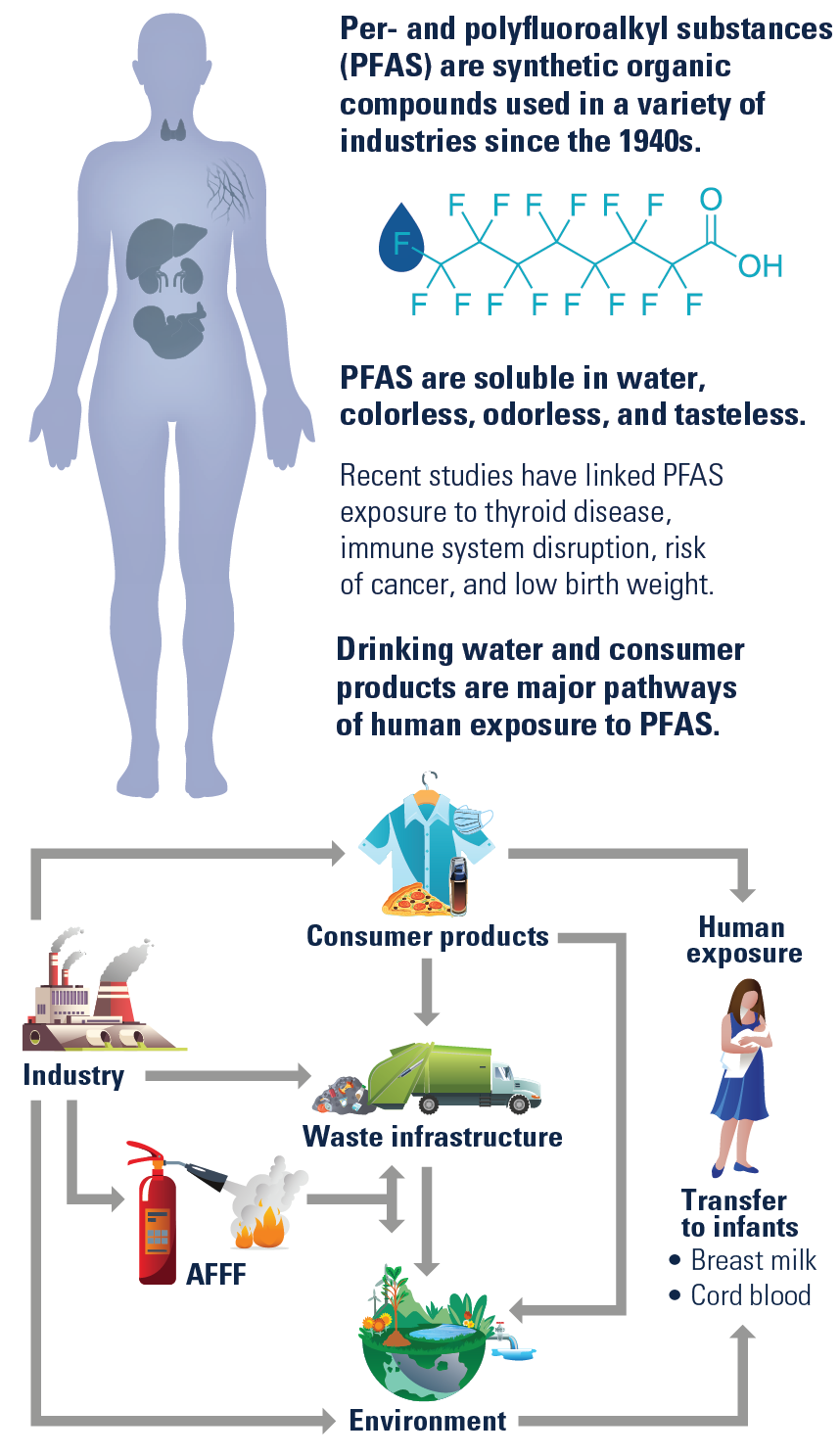
‘FOREVER CHEMICALS’ POSE MYRIAD HEALTH RISKS AND EFFORTS TO MITIGATE ARE LONG OVERDUE
The per- and polyfluoroalkyl substances known as PFAS are large and complex groups of synthetic chemicals that have been used in various products throughout the world since mid-19th century. PFAS molecules contain whole families of chemicals that are comprised of carbon and fluorine atoms. These chemicals are manmade and there are thousands of varying functional groups that can include other elements such as oxygen, hydrogen or sulfur. They are called “Forever Chemicals” because they are extremely persistent, can last for thousands of years and are almost impossible to break with currently available technology.
Perfluorooctanoic acid (PFOA) and Perfluorooctanoic sulfonic acid (PFOS) are two of the most common types of PFAS chemicals to date. Of all the PFAS chemicals, these two are the most extensively studied. Other chemicals in this group that are known to affect consumers include Perfluorononanoic acid (PFNA), Perfluorohexane sulfonic acid (PFHxS), Perfluoroheptanoic acid (PFHpA), Perfluorobutane sulfonic acid (PFBA), Perfluorodecanoic acid (PFDA) and hexa- fluoropropylene oxide dimer acid (HFPO-DA, also known as GenX Chemicals).
PFAS History, Including What Health Risks They Pose
PFAS chemicals are very stable and do not interact with other chemicals, therefore they can be very useful in making products that resist oils, stains, water, and heat. PFAS compounds were originally invented in the 1930s and were the main ingredient in non- stick cookware, waterproof products, and coatings. As time went on, the usage of PFAS chemicals increased and they were introduced to food packaging, stain resistant fabrics, cleaning products and cosmetics. They are also heavily used in industrial processes including firefighting foams used by the military, rescue agencies and airport authorities. When products containing PFAS are disposed of or spilled into lakes and rivers, they have the potential to contaminate the water. Since these chemicals cannot be demolished, they live there forever and find their way to the consumer.
PFAS chemicals were originally thought to be harmless but scientific research has determined that PFAS exposure can cause serious health issues for humans, animals, and the environment. Human risks have been linked to various cancers including kidney, liver, pancreatic and testicular. Studies also show that PFAS exposure can cause increased levels of cholesterol, risk of high blood pressure, endocrine disruption, birth defects, weakened child immunity and changes in liver enzymes for humans. Animals are known to be impacted by PFAS, as well, and numerous studies have revealed that these chemicals cause damage to the liver and immune systems for them.
Testing and Certification Standards for PFAS
A lot of U.S. communities have been impacted by PFAS contamination of their drinking water source. Therefore, the water treatment industry developed a test method and protocol called NSF P473 for testing a product’s ability to reduce PFOA and PFOS from the drinking water. At this time, the maximum product water concentration limit is set at 70 parts per trillion (ppt) combined, which means the product needs to reduce the combination of PFOA and PFOS to at or below 70 ppt. The water going into the systems is challenged with 1,500 ppt broken out as 500 ppt of PFOA and 1,000 ppt of PFOS. As the regulatory community recognized these chemicals were a significant health concern, the protocol was added to the NSF/ANSI 53 (Drinking Water Treatment Units – Health Effects) standard. As more research became available and individual states promulgated lower allowable concentrations in drinking water, the industry reconvened and agreed that an updated version of the NSF/ANSI 53 standard needed to be published.
In February 2023, the maximum allowable product water concentration limit was lowered to 20 ppt for PFOA and PFOS combined. In addition, the standard included the option of testing PFHpA (influent concentration 40 ppt), PFHxS (influent concentration of 300 ppt), and PFNA (influent concentration of 50 ppt). If the product reduces the concentration of each of the substances to 20 ppt and 6 ppt for PFNA, it is allowed to make specific claims for each of these substances. Moreover, the standard also provides products with the ability to test for a “Total PFAS” claim. This option requires testing 7 substances as a slurry in the influent water. In addition to the 5 substances mentioned above, the slurry also contains PFBS (influent concentration of 260 ppt) and PFDA (influent concentration of 10 ppt). The PFBS and PFDA have not been included as individual contaminant reduction claims because current data indicates they do not occur at levels higher than their established advisory levels. The maximum concentration limit for “Total PFAS” has been set to 20 ppt, as well. IAPMO R&T is one option available to conduct testing and certification services for all PFAS covered in the recent version of NSF/ANSI 53.

EPA Efforts on PFAS
The EPA has shown a commitment to providing meaningful, understandable, and actionable information on PFAS. The EPA was first alerted about PFAS being a health hazard as toxic chemicals in 1998. Between 2000 and 2002, PFOS was voluntarily phased out of production in the United States by a primary manufacturer. In 2006, major companies voluntarily agreed to phase out PFOA related chemicals, as well. The EPA then published provisional health advisories in 2009 to assess potential risk from exposure to PFOA and PFOS chemicals. This came after limited testing of agricultural sites in Alabama where sewage sludge was applied from a local wastewater treatment plant that received wastewater from numerous industrial sources. Public drinking water from Lawrence and Morgan counties was analyzed and found to have lower than 40 ppt in concentration, which was deemed not of a concern at that time.
The EPA was not satisfied and continued research related to PFAS chemicals. With evolving science, the EPA released lifetime health advisories in 2016 for PFOA and PFOS (the 70 ppt level mentioned above). However, the work on PFAS continues because more evidence of other PFAS contamination continues to surface. Recently, on March 14, 2023, the EPA announced the proposed National Primary Drinking Water Regulations (NPDWR) for six PFAS, including PFOA, PFOS, PFNA, HFPO-DA, PFHxS and PFBS.
The EPA has proposed maximum concentration levels of 4 ppt for PFOA and PFOS. They are also proposing a unitless hazard index of 1 for the other 4 PFAS chemicals. The hazard index will be calculated by dividing a measured concentration of HFPO-DA, PFBS, PFNA and PFHxS by 10 ppt, 2000 ppt, 10 ppt and 9 ppt respectively and then accumulating them. The calculated hazard index number will have to be lower than 1. Currently this proposal is in public comment period and has not been finalized, but the EPA anticipates finalizing the regulation this year. The expected effective date at which municipalities are expected to comply is three years post finalization.
Importance of PFAS Regulations and Consumer Options
The use of PFAS chemicals is coming close to a century old and the products in which they are used are so wide ranging, it is nearly impossible to avoid them. Exposure is inevitable. Because simple disposal is not an option — the reality is that they can live in the human body forever and cause a variety of illnesses — it is very important to regulate them.
As a consumer, you cannot avoid PFAS completely, but you can try to reduce the exposure by getting rid of non-stick cookware, avoiding stain-resistant and water repellent clothing, stain resistant furniture and stop reheating food that has been wrapped in grease resistant packaging. For drinking water, consumers should check with their local water boards to find out any advisories that have been set for PFAS. If there are concerns regarding PFAS in the community, water filters certified to remove PFAS are the best option to minimize the exposure to PFAS chemicals from the water. These steps should help reduce PFAS levels in bloodstreams, which could help ward off various illnesses.
Vandit Shah
Last modified: May 8, 2024
